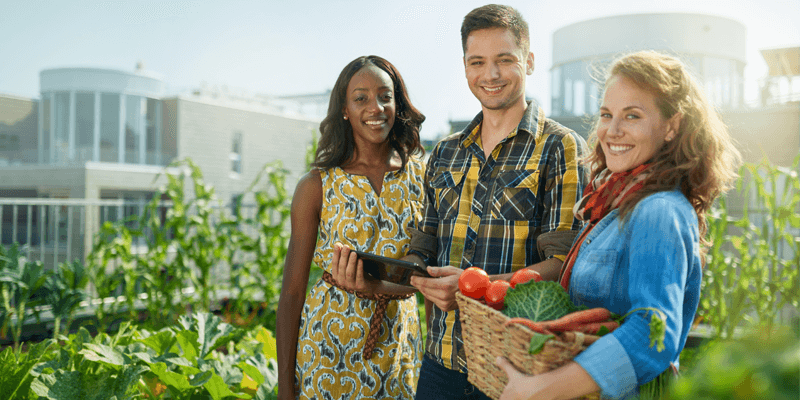


Local, sustainable food is trending right now, and more and more restaurants are adopting the concept. It’s not just fine dining restaurants adopting it either, quick service and fast casuals are also participating. The millennial generation was a huge influence on this trend, and eating healthier is here to stay. Purchasing bulk ingredients from commercial farms might seem like the easier option, but you could be missing out on not just a huge customer base but much more. Below are the reasons why restaurants are going local for their food.
It Tastes Better
The bottom line, the fresher the ingredients, the better the food will taste. Commercially grown fruits and vegetables are engineered to travel over longer distances. Usually, your grandma’s chocolate cake tastes better coming out of the oven than buying a pre-packaged cake from the grocery. Additionally, the chemicals commercial farms put on their foods for long distance can make a difference when it comes to taste. When it comes to small, local farms, produce and other items are usually sold within 24 hours of being harvested so using chemicals is usually not necessary for consumers.
Great for Marketing
Have you ever heard a customer complain about eating food from local farms or gardens? The idea of eating locally grown and sustainable food tells a story. The more you advertise or market your local concept, the more people that will come running. According to the National Restaurant Association, 57 percent of adults say they look for limited-service restaurants that serve locally sourced food, while 45 percent say an important factor is the availability of organic or environmentally friendly food. People automatically associate this with a higher quality product. “Farm-fresh” and “locally grown” are currently buzz words that are creating engagement in restaurant market.
Great for the Environment
Think about it, locally grown food cuts down on an airplane, automotive or other shipping methods. According to the EPA, crop and livestock production for food contribute 9% to greenhouse gas emissions. Ever heard of the greenhouse effect? Too many greenhouse gas emissions don’t allow the earth to soak up enough of the sun’s energy. The Greenhouse effect is not a bad thing, but what we are experiencing is an increased Greenhouse effect and Earth is getting warmer and warmer. Even cutting emissions from a small percentage of a contributing factor can make a huge difference to Earth’s environment.
Great for the Local Economy
Usually, money spent within your own community is reinvested with other businesses and services within your same community. Restaurant owners pay the farmers who grow the food, then the farmers pay their employees, and those employees pay their personal bills. When your restaurant partners with local food growers, the community as a whole benefit. A successful partnership means having an adequate number of jobs. It also doesn’t hurt to create and foster effective relationships within the local community.
Our aquarium plants for beginners and fishing-boating-outdoor productions are no-nonsense, outdoor-related events featuring quality retailers, manufacturers, destinations, outfitters and service providers.
Costs
It’s a common misconception that locally grown foods are more expensive than buying commercial food items. In some places, local food can be cheaper because of lesser transportation costs. Sometimes locally grown food can be a little more expensive, but the food is fresher. Remember, you get what you pay for. If you shop around locally, you also have a higher likelihood of finding deals and discounts. Large commercial farms usually don’t like to give away too much when it comes to pricing for individual buyers. They are able to effectively able to generate the product in a large size and have clients from far away they work with.
Creates Healthy Consumers
Healthy customers are usually happy customers, and happy customers create more profits. When fruits and vegetables are ripe they are usually at their healthiest. When you can bring a 24 hour farm to table process rather than a week’s time period, it can make a huge difference. Even if your customers change nothing else about their ordering patterns, this can still make a world of difference for their diets.
Preserves the Small Farm Name
Small farms are dwindling, and are being pushed out by strip malls and residential neighborhoods. When you support or do business with a small farm it helps them stay in business. Small farms are also able to grow some food items that large commercial farms can handle. Customers may be more likely to try a restaurant that mixes up the ingredients on the menu.
Creative Menu Options
Most people recommend changing up your menus, and a great way to do that is on a seasonal basis. There are some food items that grow continuously all year. However, many restaurant owners like being able to get creative and design a menu of what’s in season. They, in turn, tie that into what’s growing locally. Say you live in the area where Bell peppers are in season during the summer. It would be trendy if you mixed bell peppers into your menu.
Local Means More Knowledge
Working with a local farmer vs. a commercial or large wholesale farm is a completely different type of relationship. Good local farmers know exactly how the food was planted, and what it took for it to grow. When a local farmer is able to communicate that to the restaurant owner, it goes an extra mile with the restaurant customer, and they ask something like, “How were these amazing onions grown?” Gardening and effective sustainability are hot topics right now, so you never know who or when they will ask.